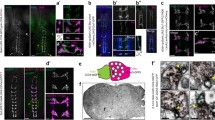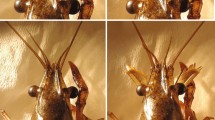Summary
Cockroaches (Periplaneta americana) have been shown to adapt behaviorally, in about 1 month, to ablation of one cercus. Additionally, those giant interneurons (GIs) that normally receive their major input from the lesioned cercus become more responsive to stimulation of the intact side (Vardi and Camhi 1982 a, b). To investigate the role of afferent activity in the behavioral and neuronal plasticity, we silenced wind-evoked activity in the intact cercus by immobilizing the sensory hairs. This was carried out during the last nymphal stage which lasts for about one month. The animals were tested behaviorally and physiologically after they had molted to adults and a fresh set of mobile hairs had appeared. These animals showed no behavioral correction (Fig. 3). The responses of the GIs on the ablated side were somewhat enhanced, but they were also significantly smaller than those in animals with long-term cercal ablations and no sensory deprivation (Fig. 5). A variety of controls (Figs. 8, 9, and 10) were used to show that sensory deprivation by itself did not decrease the responsiveness of the afferents or the GIs. Thus elimination of wind-evoked activity specifically decreasesenhancement of the responses in the GIs.
Similar content being viewed by others
Abbreviations
- GI :
-
giant interneuron
References
Brown MC, Holland RL, Hopkins WG (1981) Motor nerve sprouting. Annu Rev Neurosci 4:17–42
Buño W Jr, Monti-Bloch L, Crispino L (1981a) Dynamic properties of cockroach cercal bristlelike hair sensilla. J Neurobiol 12:101–121
Buño W Jr, Monti-Bloch L, Mateos A, Handler P (1981 b) Dynamic properties of cockroach cercal threadlike hair sensilla. J Neurobiol 12:123–141
Callec J-J, Sattelle DB (1973) A simple technique for monitoring the synaptic actions of pharmacological agents. J Exp Biol 59:725–738
Camhi JM (1976) Non-rhythmic sensory inputs: influence on locomotory outputs in arthropods. In: Herman RM, Grillner S, Stein PSG, Stuart DG (eds). Neural control of locomotion Plenum, New York, pp 561–586
Camhi JM, Comer (1986) Modeling the information in groups of identified cells: giant interneurons and cockroach escape behavior. Soc Neurosci Abstr 12:202
Camhi JM, Tom W (1978) The escape behavior of the cockroachPeriplaneta americana. I. Turning response to wind puffs. J Comp Physiol 128:193–201
Comer C (1985) Analyzing cockroach escape behavior with lesion of individual giant interneurons. Brain Res 335:342–346
Dagan D, Camhi JM (1979) Responses to wind recorded for the cereal nerve of the cockroachPeriplaneta americana. II. Directional selectivity of the sensory neurons innervating single columns of filiform hairs. J Comp Physiol 133:103–110
Daley DL, Vardi N, Appignani B, Camhi JM (1981) Morphology of the giant interneurons and cereal nerve projections of the American cockroach. J Comp Neurol 196:41–52
Dichgans J, Bizzi E, Morasso P, Tagliasco V (1973) Mechanism underlying recovery of eye-head coordination following bilateral labyrinthectomy in monkeys. Exp Brain Res 18:548–562
Dieringer N, Precht W (1979) Mechanisms of compensation for vestibular deficits in the frog. I. Modification of the excitatory commissural system. Exp Brain Res 36:312–328
Dowd JP, Comer CM (1986) Testing models of sensorimotor integration: Computer simulations of escape turning behavior in the cockroach. Soc Neurosci Abstr 12:202
Dyson SE, Jones DG (1984) Synaptic remodelling during development and maturation: junction differentiation and splitting as a mechansim for modifying connectivity. Dev Brain Res 13:125–137
Fifkova E, Harreveld A van (1977) Long-lasting morphological changes in dendritic spines of the dentate granular cells following stimulation of the entorhinal area. J Neurocytol 6:211–230
Flohr H, Bienhold H, Abeln W, Macskovics I (1981) Concepts of vestibular compensation. In: Flohr H, Precht W (eds) Lesion induced neuronal plasticity in sensorimotor systems. Springer, Berlin Heidelberg New York, pp 153–172
Harris WA (1981) Neural activity and development. Annu Rev Physiol 43:689–710
Huber F (1987) Plasticity in the auditory system of crickets: phonotaxis with one ear and neuronal reorganization within the auditory pathway. J Comp Physiol 161:583–604
Knudsen EI (1983) Early auditory experience aligns the auditory map of space in the optic tectum of the barn owl. Science 222:939–942
Knudsen EI, Knudsen PF (1985) Vision guides the adjustment of auditory localization in young barn owls. Science 230:545–548
Knudsen EI, Knudsen PF, Esterley SD (1984) Monaural occlusion alters sound localization during a sensitive period in the barn owl. J Neurosci 4:1001–1011
Krasne FB (1987) Silencing normal input permits regenerating foreign afferents to innervate an identified crayfish sensory interneuron. J Neurobiol 18:61–73
Maehlen J, Nja A (1982) Effects of electrical stimulation on sprouting after partial denervation of guinea-pig sympathetic ganglion cells. J Physiol (Lond) 322:151–166
Matsumoto SG, Murphey RK (1977) Sensory deprivation during development decreases the responsiveness of cricket giant interneurones. J Physiol (Lond) 268:533–548
Matsumoto SG, Murphey RK (1978) Sensory deprivation in the cricket nervous system: Evidence for a critical period. J Physiol (Lond) 285:159–170
Miles FA, Lisberger SG (1981) Plasticity in the vestibulo-ocular reflex: a new hypothesis. Annu Rev Neurosci 4:273–299
Murphey RK, Levine R (1980) Mechanism responsible for changes observed in response properties of partially deafferented insect interneurons. J Neurophysiol 43:367–382
Nicklaus R (1965) Die Erregung einzelner Fadenhaare vonPeriplaneta americana in Abhängigkeit von der Größe und Richtung der Auslenkung. Z Vergl Physiol 50:331–362
Nicon B, Poucette R, Jackson PC, Diamond J (1984) Impulse activity evoked precocious sprouting of nocioceptive nerves into denervated skin. Somatosensory Res 2:97–126
Palka J, Edwards JS (1974) The cerci and abdominal giant fibers of the house cricket,Acheta domesticus. II. Regeneration and effects of chronic deprivation. Proc R Soc Lond B 185:105–121
Precht W, Shimazu H, Markham CH (1966) A mechanism of central compensation of vestibular function following hemilabyrinthectomy. J Neurophysiol 29:996–1010
Shepherd D, Murphey RK (1986) Competition regulates the efficacy of an identified synapse in crickets. J Neurosci 6:3152–3160
Stewart WW (1978) Functional connections between cells as revealed by dye-coupling with a highly fluorescent naphthalimide tracer. Cell 14:741–759
Vardi N (1981) Functional recovery from lesions in the escape system of the cockroach. PhD Thesis, Cornell University, Ithaca, NY
Vardi N, Camhi JM (1982a) Functional recovery from lesions in the escape system of the cockroach. I. Behavioral recovery. J Comp Physiol 146:291–298
Vardi N, Camhi JM (1982b) Functional recovery from lesions in the escape system of the cockroach. II. Physiological recovery of the giant interneurons. J Comp Physiol 146:299–309
Volman SF (1985) Synaptic plasticity in response to partial deafferentation of giant interneurons in the American cockroach. Soc Neurosci Abstr 11:959
Volman S, Camhi JM (1982) The role of activity in neuronal plasticity in the cockroach. Soc Neurosci Abstr 8:17
Volman S, Camhi JM, Vardi N (1980) Role of sensory activity in behavioral recovery of the directional escape response of the cockroach. Soc Neurosci Abstr 6:679
Westin J (1979) Responses to wind recorded from the cereal nerve of the cockroachPeriplaneta americana. I. Response properties of single sensory neurons. J Comp Physiol 133:97–102
Westin J, Langberg JJ, Camhi JM (1977) Responses of giant interneurons of the cockroachPeriplaneta americana to wind puffs of different directions and velocities. J Comp Phyisol 121:307–324
Zigmond RE, Bowers CW (1981) Influence of nerve activity on the macromolecular content of neurons and their effector organs. Annu Rev Physiol 43:673–687
Author information
Authors and Affiliations
Rights and permissions
About this article
Cite this article
Volman, S.F., Camhi, J.M. The role of afferent activity in behavioral and neuronal plasticity in an insect. J. Comp. Physiol. 162, 781–791 (1988). https://doi.org/10.1007/BF00610967
Accepted:
Issue Date:
DOI: https://doi.org/10.1007/BF00610967




